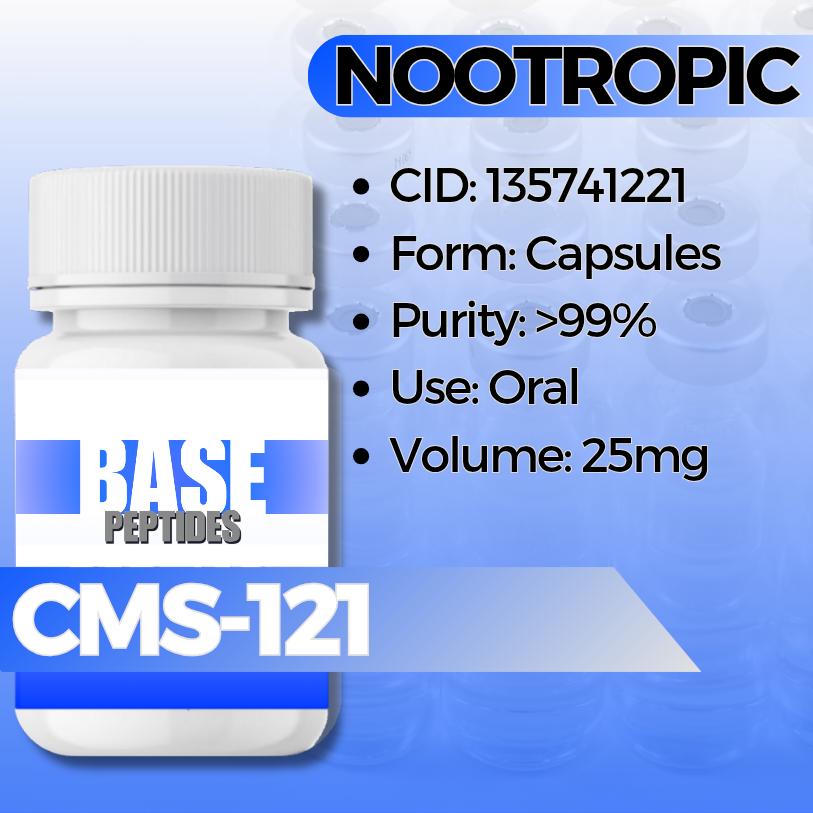CMS-121
CMS-121
Base Peptides are intended for licensed medical professionals and experienced researchers. Reconstitution required. Dosing and use instructions are not provided.
Couldn't load pickup availability
CMS121 — ACC1 & FASN Modulator (GeroneuroProtective Small-Molecule)
CMS121 is a synthetic derivative of the flavonoid Fisetin, developed for research into neurodegeneration, metabolic dysfunction and age-related lipid dysregulation. It has shown promising activity in pre-clinical models involving lipid synthesis suppression, oxidative stress reduction and cognitive preservation.
- Synonyms: CMS-121, CMS121, CMS 121
- CAS No: 1353224-53-9
- Formula / MW: C20H19N O3 • ~321.37 g∙mol⁻¹
- Primary targets: Acetyl‑CoA Carboxylase 1 (ACC1) and Fatty Acid Synthase (FASN) — key lipogenesis enzymes.
- CMS121 inhibits ACC1 and FASN, slowing the creation of new fatty acids inside cells and reducing the pool of lipids that can undergo harmful peroxidation.
- This leads to less oxidative damage from lipid-peroxides, improved mitochondrial and cellular health, and a reduction in inflammatory/age-related stress signaling.
- Because excess lipid synthesis and peroxidation are implicated in neuro-degeneration, metabolic disease and ageing, CMS121 is used to explore these mechanisms.
- To investigate how reducing lipogenesis impacts memory decline, oxidative damage and lipid peroxidation in neurodegeneration models.
- To explore metabolic and aging-related endpoints such as obesity, inflammation, insulin resistance and organ-damage markers.
- To assess mitochondrial markers, lipidomics, and cellular resilience in translational ageing studies.
Key Studies — What Was Tested, What Changed, Why It Matters
Transgenic Alzheimer’s Model: Lipid Peroxidation & Cognition
- What was tested: Mice (APPswe/PS1ΔE9) with Alzheimer-like pathology treated with CMS121 (~34 mg/kg/day for 3 months).
- What changed: Cognitive performance restored to wild-type levels; lipid-peroxidation markers (4-HNE adducts) and 15-LOX2 levels reduced in hippocampus.
- Why it matters: Demonstrates the link between lipid metabolism and neuro-degeneration and positions CMS121 as a tool for studying this axis.
Metabolic & Aging Models: Obesity, Liver + Kidney Protection
- What was tested: Aged/diet-induced metabolic models treated with CMS121 (6 months diet containing CMS121) assessing weight gain, glucose/lipid parameters, liver/kidney.
- What changed: ~40% less weight gain, improved glucose/lipid profiles, lowered hepatic inflammatory markers, improved kidney mitochondrial proteins.
- Why it matters: Suggests lipogenesis inhibitors may protect peripheral organs and entire metabolic system, not just brain.
Potential Research Applications
Neurodegeneration & Ageing
- Alzheimer’s-models, oxidative stress, lipid peroxidation, cognitive assays.
Metabolic & Obesity Research
- Age-related obesity, insulin resistance, hepatic steatosis, kidney damage models.
Lipidomics & Mitochondrial Biology
- Lipid-synthesis suppression, mitochondrial markers (TFAM, Nrf1), lipid peroxidation readouts.
Synergistic / Comparator Compounds
BAM15 (Mitochondrial Uncoupler)
- Why pair: Combine lipogenesis inhibition (CMS121) with energy-expenditure activation (BAM15) for multi-axis metabolic read-out.
NMN (Nicotinamide Mononucleotide)
- Why pair: Mitochondrial/NAD⁺ pathway + lipid metabolism modulation may produce layered bioenergetic outcomes.
SLU-PP-332 (Pan-ERR Agonist)
- Why compare: Exercise-mimetic vs lipogenesis suppression—contrast different metabolic entry-points in obesity/aging studies.
Known Concerns (Context)
- Pre-clinical tool compound: While CMS121 has entered Phase 1 (safety) studies, therapeutic use is not established—use in research context only.
- Target breadth: Modulating ACC1/FASN affects multiple lipid pathways—off-target effects and compensatory metabolism may influence results.
- Model specificity: Many positive findings are in ageing/AD or diet-induced models; translation to other tissues/systems may vary.
- General: For laboratory research use only; not for human consumption or therapeutic use.
Specifications & Handling
- Form: Small-molecule solid (lot-coded) — verify free base.
- Storage: Dry, preferably ≤ −20 °C; protect from light and moisture.
- In solution: Soluble in DMSO/ethanol; record solvent %, pH, time-to-assay; avoid multiple freeze-thaws.
- Labeling: Tamper-evident; research-only; lot/SKU clearly displayed.
Regulatory & Use Notice
Sold for laboratory research use only. Not for human consumption, medical, or veterinary use. No human-use instructions are provided. Buyer is responsible for safe handling and regulatory compliance.
CMS121 Research Compound | ACC1 / FASN Lipogenesis Modulator | Neurodegeneration, Metabolic & Ageing Studies


